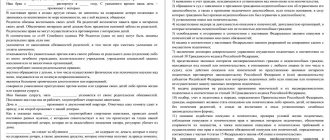In what cases is money paid to the account of a minor?
Payment of part of the payment to a deposit is possible if the payer submits such a request. However, the court has the right to either accept or refuse such a proposal from the defendant.
The court will make its decision based on the following factors:
- Amount of assigned payments. It is obvious that if the amount of payments for the maintenance of a minor is small, then there are serious difficulties even in providing basic needs, which does not allow saving part of these payments for the future. At the same time, significant monthly payments that the payer makes on time and constantly encourage the court to credit part of the funds to the child’s deposit.
- Responsibility of the recipient of alimony. One of the most common grounds for crediting part of the payments to the account of a minor is the suspicion of the alimony payer that the payments are being spent for other purposes. If such suspicions can be supported by documents, the court is guaranteed to make a decision to credit part of the payments to the child’s account.
- Age of the minor. As you know, a person who has reached the age of 14 has the right to independently manage their own funds. Thus, crediting money to his deposit, with the consent of the trustee, will allow him to independently spend funds on his maintenance, based on his own needs.
What documents need to be submitted to the court?
The applicant provides the court with the following package of documentation:
- claim;
- your passport;
- certificate of registration of the marital union or its dissolution;
- court order to collect alimony payments;
- the bailiff's decision to initiate enforcement proceedings;
- documents proving the fact that the parent with whom the child lives is spending the funds received irrationally.
The following may be used as evidence:
- checks and receipts establishing the fact that the parent spent money on meeting personal needs;
- receipts for repayment of loans and borrowings that were issued by the parent for their own needs;
- photos and videos;
- witness statements;
- a certificate stating that a large debt has accrued for paying for kindergarten attendance;
- police or prosecutor's reports and juvenile records.
The act of checking the child’s living conditions is of particular importance. This document is drawn up by guardianship officials.
During the consideration of the case by the court, the alimony provider is recommended to demand from the defendant:
- report on alimony income and expenses;
- documentation on credit debts;
- certificates about whether the defendant has traveled to other countries and cities over the past few months, whether he has made large financial expenses (for example, on expensive repairs, the purchase of household appliances that are not intended to meet the basic needs of the child).
The alimony recipient will be required to provide the court with the details of the account that he previously opened with the bank. If the court decision is satisfactory, the plaintiff will begin to transfer alimony exactly to the account specified by him.
As for the court decision, this body has the right to meet the plaintiff halfway and change the procedure for making alimony payments. The child support provider will transfer no more than 50% of the amounts to the children's bank account. The legislation does not allow the entire transfer of alimony amounts to the account - at least half must be transferred to the current needs and requirements of the minor.
Forced transfer of part of the content to bank details
If the parties cannot determine the amount of deductions to the account, the alimony payer has the right to file a claim in accordance with Article 60 of the Family Code of the Russian Federation. In form, this can be as a counterclaim, if a case regarding collection is being considered in parallel, or filing a statement of claim if maintenance payments have already been assigned.
The court determines what percentage of the total amount can be credited to the account and also indicates the method of crediting the funds.
Who has the right to withdraw funds and in what cases?
The following have the right to withdraw the child’s money:
- Guardian (parent or other person who has established guardianship or trusteeship of the child). The trustee may withdraw money from the deposit solely for his benefit. Such interests include large amounts of payments for the treatment or education of a minor. The payer of the payments has the right to demand an account of this money, as well as go to court if he sees abuses in the actions of the trustee.
- A child who has reached the age of 18. Having received full legal capacity, the guy can independently manage all the funds accumulated in the account. In some cases (marriage, starting a business), a minor may receive the right to use his money before reaching 18 years of age.
Basic information
If the initiator of the change in payment transfer option is the alimony provider, then with a positive court ruling, he will transfer no more than 50% of the total amount of alimony. When the recipient of alimony is sent to the court with this demand, then in this situation the entire amount without a balance can be transferred to a specialized “children’s” account. As a result, by the time he reaches adulthood, he will have accumulated a decent amount of money.
Let's look at how child support providers can secure their funds and start transferring money to the child, not the mother.
The legislation establishes the following right: the recipient of alimony, acting as a representative of the child, manages the transferred money to meet the needs and requirements of the minor. The latter may include spending on education, medical procedures, purchasing basic necessities, and purchasing food.
If the child support provider understands that the second parent spends money on his own needs (for example, after a divorce and the establishment of alimony, he began to travel frequently to other countries and cities, purchased expensive equipment), then in this case he has the opportunity to open a “children’s” account and transfer the money is for him.
Changing your payment method
There are situations when the recipient of alimony needs to change the bank details for payments, for example, to receive them on a bank card.
If the parties have come to an agreement on the form of payments voluntarily and (or) agree with such a change in details, it is necessary to draw up an additional agreement that establishes a certain amount of payments transferred to the new bank details.
According to the Family Code of the Russian Federation, both parents undertake to provide for the child until the age of 18. In practice, during a divorce, one of the spouses may not fulfill his obligation; for this reason, collections are carried out through court proceedings.
Expert opinion
Kuzmin Ivan Timofeevich
Legal consultant with 6 years of experience. Specializes in the field of civil law. Member of the Bar Association.
Dear readers! The article talks about typical ways to resolve legal issues, but each case is individual. If you want to find out how to solve your particular problem , contact a consultant:
APPLICATIONS AND CALLS ARE ACCEPTED 24/7 and 7 days a week.
Every year, the State Duma adjusts bills on the calculation of alimony. Let’s look at how the process works in 2020, the norms, rules and whether a parent can transfer child support to the child’s account in more detail.
Procedure for opening a child account
Many financial institutions offer such a service for child support providers - programs for saving and increasing the amount of financial deposits until the client’s child is 18 years old. Such programs allow you to constantly replenish your account, as well as withdraw money from it by those people who have the right to do so (the child, his parent, trustee or guardian).
To open a child support account for a child, you will need to complete the following steps.
- A specialized bank account is opened at the request of the alimony provider. He will need to provide the bank employee with his passport, as well as a birth certificate for the baby.
- The second step is to contact the court department with a request to change the method of transferring alimony payments. It is necessary to first draw up a claim and submit to the court documentation containing information about bank details.
If the alimony recipient does not go to court after opening a bank account, then all the money transferred by him will be counted as auxiliary material support, and arrears will arise for alimony
.
Payment procedure
Today, many alimony recipients become debtors, and children, as a rule, are left without financial support. That is why bills related to alimony are aimed at eliminating debt.
In such a situation, the Federal Pension Fund undertakes to transfer money in favor of children under 18 years of age and is assigned the status of “survivor’s pension.”
The recipient of the alimony has the right to write an application to the court due to the end of the year from the date of searching for the payer.
In addition, it was proposed in the legislative act:
| Fix the maximum period for searching for a payer (1 year) | After the time has passed, the case is closed, and the applicant is called for a consultation to create a claim to confirm the missing debtor |
| As soon as the judge makes a positive decision | A survivor's pension is issued in the child's name |
| To date, the project is in the process of being finalized | It is possible that in the future it will not take effect |
Federal Law-309 of October 30, 2017 on the payment of alimony to amend paragraphs 2 and 3 of Article 27 of the Code of Administrative Offenses. Now bailiffs can detain and deliver the debtor to the department for an explanation without the police.
The form of punishment has also changed when one of the parents has arrears in child support, namely:
- a fine of up to 20 thousand rubles is imposed;
- forced correctional labor;
- administrative arrest for up to 15 days.
Important! In order for the punishment to take effect, the offender must be invited to explain the situation.
The indexation of cash payments to a young child is required to be carried out by the managers of the company where the debtor works, regardless of the provision of a writ of execution; this can be done by both the bailiff and the collector.
The management undertakes to increase payments in a fixed amount of money quarterly, justifying them with changes in the regional cost of living.
Before changes in the law, indexation was the concern of bailiffs. Now the obligation has been removed and thus the protection of children's rights related to alimony has become better.
Application to change the procedure for executing a court decision
If alimony was paid on the basis of a court decision, then in order to arrange the transfer of part of the money to the account, one should be guided by Article 203 of the Code of Civil Procedure of the Russian Federation.
So, in this case, there is a need to change the procedure for executing a court decision. This can be done by submitting an appropriate application.
It should be borne in mind that the court is not obliged to grant such a claim if it considers it inappropriate. At the same time, he has the right to change the payment procedure at his own discretion.
How to make an application?
So, it all starts with drawing up a statement of claim. It must meet the requirements described in Article 131 of the Code of Civil Procedure of the Russian Federation. This document is drawn up in written form. However, it can be drawn up by hand or printed on a computer. The following information must be reflected here :
- information about the judicial authority to which the claim is filed (name, address, etc.);
- personal data of the plaintiff and defendant (full name, residential address, contact numbers);
- the subject of the claim (the specific situation is described, the grounds for changing the payment procedure are indicated, specific demands are put forward);
- list of papers attached to the document.
Particular attention should be paid to the grounds for the claim being brought forward . It is important to present in court significant evidence of the fact that the ex-spouse is spending alimony for unrelated purposes. Otherwise, the requirements may not be met.
It is best to entrust the process of preparing a statement of claim to an experienced lawyer who can draw up this document in a legally competent manner.
Which court should I go to?
The statement of claim should be filed with the same judicial body in which the decision to assign monetary support in favor of the minor was previously made.
The procedure for executing the decision
Based on the results of consideration of the issue of changing the procedure for executing a court decision, an appropriate determination is made . Moreover, if the claim is satisfied, the mother (father) with whom the child lives can appeal the final decision by filing a frequent complaint (clause 3 of Article 203 of the Code of Civil Procedure of the Russian Federation).
The procedure for executing a court decision will have the following general form:
- After the adopted changes enter into legal force, the applicant must receive a writ of execution and take it to the Federal Bailiff Service (FSSP).
- Next, the ex-husband or wife should go to the bank and open an account in the name of their child (as a rule, this is done by the recipient of the funds).
Some experts recommend opening a bank account first and then starting the legal process.
With voluntary agreement
Expert opinion
Kuzmin Ivan Timofeevich
Legal consultant with 6 years of experience. Specializes in the field of civil law. Member of the Bar Association.
Registration of alimony without judicial intervention is possible through the conclusion of an agreement between the parties, which is based on voluntary payments of funds to the child.
This method allows you to avoid the financial and time costs that definitely occur when visiting court.
As a guarantee against scandals, there may be a receipt with detailed information and situations.
It is recommended to keep checks and receipts that prove that money has been transferred to the child.
When drawing up an agreement, it is worth notarizing it, indicating the amount, procedure and timing of payments. Such a document can be drawn up both during marriage and after divorce.
Alimony, as a rule, is often collected from the father in the form of a specified specific amount or percentage of salary.
The transfer method and schedule may change: once a quarter, month, year, or one-time in the form of some property (car, real estate, land).
Photo: sample application for agreement of the parties
Upon a court decision
The State Duma has a bill that stipulates an increase in the minimum maintenance payments to children to 15 thousand rubles - subject to indexation.
It is planned that the amount of money will be transferred regardless of the financial condition of the parents. Of course, people react differently, since in many regions of Russia the average income is below a fixed amount .
The minimum child support in 2020 may be part of the subsistence level. In the case where parents do not have the means to support them, this is not a reason not to fulfill their responsibilities towards their children.
Payments may be withheld from a non-working parent. The smallest amount, provided the parent is unemployed, is established by the court in accordance with the cost of living in a particular region of residence. At the federal level, the cost of living for children is 9,400 rubles.
When funds are collected forcibly through bailiffs, one of the parties provides a new writ of execution.
Important! The offspring has the right to manage money after the age of 14 with the written approval of the parents. Until this point, accumulation will occur.
How to put some money in the bank
Often, payers are worried that I will transfer money to my wife and not to my child. Those paying child support can transfer the amount to the child's account, avoiding transfer to the other parent. This is enshrined in Article 60 of the Family Code.
Based on the law, the judge may decide to transfer the amount to the child’s bank account. As a rule, this happens before adulthood.
Important! No more than 50% of the amount is allowed to carry out transactions into a bank account; the second part will have to be transferred to the legal representative to support the child.
When a transfer occurs without a court decision or notarization, such actions are assessed as charity and are in no way related to alimony.
However, it is not always possible to transfer funds to a child under 18 years of age rather than to a guardian. As a rule, if a parent does not spend money on the child, the court will side with the payer.
Initiative coming from the recipient of alimony
Not only the payer, but also the parent who receives the funds can change the method of collecting withheld funds. For example, the mother of a minor may apply to the judicial authorities to cancel the transfer of collected funds to her current account, and ask for a decision to transfer the withheld funds directly to the child’s bank account. This happens if the mother decides to leave the country or has the financial ability to support the children on her own.
To do this, the mother will need to contact the bailiffs with a statement indicating the intention to change the details for transferring alimony. The changed details are sent to the place of deduction of funds from the income of the alimony payer, namely to the place of work. The mother can make changes to the details for transfers if she personally presented the writ of execution by submitting an application to the place of work of the alimony payer or the bailiff service.
How often should payments be made?
Expert opinion
Kuzmin Ivan Timofeevich
Legal consultant with 6 years of experience. Specializes in the field of civil law. Member of the Bar Association.
As a rule, so that the rights of the child are not infringed, material payments are made monthly on a pre-agreed day, which is indicated in the document. When the parents have entered into an Agreement, the transfer can be carried out more often or on set dates.
It happens that alimony is withheld by an accounting employee in the organization where the debtor works. Regardless of the specified salary schedule, deductions are made once a month.
For this reason, more often than not, companies issue advance payments and wages, thus, 2 times a month. Sick leave is also deducted.
How to open a personal account for your daughter or son in this situation?
In order to open a bank account in the name of a minor, you must follow the following steps :
- First you need to choose a suitable bank.
- Next, you should begin drawing up an application to open an account. As a rule, on the websites of many credit institutions there is a ready-made template for this document.
- Collecting a package of documents, which should include:
- ID card of one of the parents (some banks require passports of both father and mother);
- child's birth certificate;
- court decision.
- Having collected all the papers, you must send a corresponding request to the bank.
- Based on the results of consideration of the application, if all conditions are met, the bank will open an account in the name of the minor, to which further payments will be made.
Judicial practice on transfer of alimony
Based on Article 60, paragraph 2 of the Family Code, the transfer of part of the material resources to the child’s account at the request of the alimony payer without the prior approval of the recipient is referred to the court for trial.
Judicial practice in this area is typical and extensive. As a rule, situations concerning the transfer of money to children or the total amount are dealt with in court.
Before filing an application to change the order of payments, the debtor should know that:
As a rule, misappropriation of payments by the recipient is considered a common reason.
You can prove it using:
- witness statements;
- documents from the drug dispensary;
- discrepancy between the level of development according to the child’s age
| The court may change the procedure for transferring funds by transferring some part to the child’s personal account, when the required amount to be paid is higher than the norm to fully provide for the young offspring | When alimony is less than the subsistence level for children, it is most likely a refusal |
| The applicant will need to provide evidence on the basis of which the decision should be changed |
In order to prevent conflict situations, according to the recommendations of lawyers, it is best for the payer to do the following:
- transfer to a savings book;
- transfers are carried out with a certain reservation;
- give the passbook to the second parent through the guardianship authorities, who will provide confirmation of actual receipt in a certified letter;
- come to the guardianship authorities with a pre-written statement stating that the money is transferred to provide for the child and cannot be spent on other purposes.
In order for your ex-spouse to receive them, you must provide:
- Birth document.
- Passport.
- Passbook.
- The certificate issued by the guardianship authorities gives permission to withdraw money.
Who has the right to withdraw alimony from the account?
The child himself can use the money that has accumulated in a bank account if:
We recommend reading
Instructions for collecting child support in 2020 in the Russian Federation
- he has reached the age of majority (18 years old);
- a parent who lives with him, but only with the permission of the guardianship authorities. For example, if money was needed for children’s education or treatment.
There are several features in the provision of the law regarding the possibility of transferring withheld funds to the child’s account.
- The alimony payer has the right to transfer up to 50% of the withheld funds to the child’s account;
- There are no such restrictions for the parent receiving child support. Thus, the mother, who did not receive part of the funds due to limited availability of money, has the right to consider these amounts as the debt of the alimony payer.
The parent receiving child support is considered the legal representative of the minor. The mother can challenge the court’s decision to transfer part of the amounts withheld from the payer to the minor, and the judicial authorities can cooperate. In order to eliminate conflict, lawyers suggest that alimony payers do the following:
- Transfer part to a savings book;
- When translating, do not forget to indicate the purpose of the translation;
- Pass the savings book only with the help of the guardianship authorities, because they can confirm the fact of delivery of the passbook with an official letter;
- Contact the guardianship authorities by writing an application to transfer the savings book to your ex-wife. In the submitted application, it should be noted that the funds are intended to support the child, and that funds can be received and spent only if the conditions are met.
To receive funds, the ex-spouse will have to provide:
- birth certificate;
- savings book;
- your passport;
- a certificate from the guardianship authorities that they allow her to withdraw a certain amount from the savings book.
Basic Concepts
Article No. 60 of the Family Code of the Russian Federation allows for the transfer of 50% of the benefit amount to the bank account of a minor. The other half is transferred to the recipient in order to provide the child with vital needs. Legislative acts that are used by the court to make a decision on dividing alimony into 2 parts:
- Family Code of the Russian Federation;
- Resolution No. 9 of the Plenum of the Supreme Court of 1996, “On the application by courts of the Family Code of the Russian Federation when considering cases of establishing paternity and collecting alimony”;
- Civil Procedure Code, Article No. 203.
An application for division of alimony payments is considered only if the remaining amount is sufficient for the normal life of the children. You can transfer benefits to your account if the following conditions are met:
- The total amount of money paid into the account must be equal to 50% of the total amount of alimony assigned;
- The reasons that prompted the plaintiff to write a statement to the court were justified;
- The bank account for transferring payments is registered in the name of the minor;
- The bank deposit is closed until the child turns 18. Mother, father and guardians have no opportunity to receive money. Withdrawals are allowed only in force majeure circumstances.
According to the law, alimony must be directed to:
- Nutrition;
- Payment of utility bills for housing in which a minor lives;
- Games and children's clothing;
- Educational services and additional developmental clubs;
- Medicines and payment for treatment;
- Other needs necessary for the normal existence of the child.
If a woman uses children's money to pay for personal needs, buy cosmetics, alcohol or clothing, the father has the right to divide the alimony in court: 50% to the child's account, and 50% to the recipient. The court may require the mother to keep a record of the money spent.
Benefits of transferring child support into a child account
The benefits of the described method of paying alimony are the following:
- the child's mother does not have access to these funds;
- Only the immediate recipient can use the money after he/she reaches 14 years of age;
- funds are issued on the basis of a passport.
Note! The guardianship and trusteeship authority has the powers necessary to exercise control over the spending of money accumulated in a child’s account. The alimony payer has the right to allow the withdrawal of funds before the child reaches 14 years of age, subject to the approval of expenses with the guardianship authority.
Transfer of alimony to the child's account in full
According to the law, only part of the payments is subject to transfer to the children's account, namely 50% of the total amount of alimony. However, in some cases, if there are grounds, transfer of funds in full is allowed.
The basis for transferring the entire amount is:
- A document indicating that the child’s mother and father are not opposed to the fact that child support payments will go entirely to the child’s account. This consent:
- drawn up in accordance with legal requirements;
- contains information about the parties to the agreement, the amount of payments and bank details;
- subject to notarization;
- The child is in a boarding school, orphanage or other institution of this kind, which requires full provision for the child at the expense of the state;
- Establishment of guardianship over the recipient of alimony or residence of the latter in a foster family.
For information!
There are no restrictions on the maximum amount of transfers to a child’s personal account, therefore, if financially possible, the alimony payer can transfer additional funds to the child’s account. In the future, the accumulated funds can be used:
- to pay for the child’s education;
- purchase of housing;
- purchase of a vehicle;
- other needs.
The transfer of additional funds occurs on a voluntary basis; obtaining permission to implement the procedure in this case is not required.
Advice! As judicial practice shows, the difficulty in cases of changing the procedure for paying alimony mainly lies in preparing the evidence base. It is quite difficult to collect documents confirming the irresponsible attitude of the child’s mother to the transferred funds, so before filing a claim, you should consult an experienced lawyer.
In addition, it should be remembered that when making a decision, the court is primarily guided by the interests of the child, and not his parents, therefore, infringement of the child’s financial situation is unacceptable.
Who can initiate the process of dividing alimony?
As practice shows, the main initiators of cases regarding the division of alimony benefits are payers. Using Article No. 203 of the Code of Civil Procedure of the Russian Federation, the father can file an application with the court with a request to change the method of collection and the procedure for paying money for child support.
There are cases when a mother living with her children herself thinks about transferring part of the alimony payments to the account. This can be explained by the woman’s desire to save money for education or to buy an apartment for a minor in the future.
There are two ways to implement the mother’s initiative:
- After receiving the benefit, the mother independently transfers part of the money or the full amount to the bank;
- The woman draws up an application in which she requests that 50% of the child support be transferred to the child's savings account.
If the mother initiated the process of dividing the child benefit, she needs to submit an application for its execution.
The algorithm of actions is as follows:
- Send the writ of execution and application to the Bailiff Service. The document indicates the new details of the account opened for the child;
- Apply to the organization where the alimony payer works.
When contacting the accounting department of the enterprise, you will need to provide a copy of the writ of execution, details of the personal account of the child, mother and information about the financial institution.
Procedure for the recipient of alimony
The second parent, who actually cares for the minor and receives payments for him, can also have part or all of the amount transferred to the child’s personal account.
This happens when this parent has enough funds to independently support the minor. He also needs to submit an application to the court with a request to review the payment method and to transfer part or all of the amount to other details.
As soon as the court makes a positive decision, it and the new payment details must be submitted to the place where payments are transferred. That is:
- To the bailiff service;
- At the place of work of the alimony payer.







